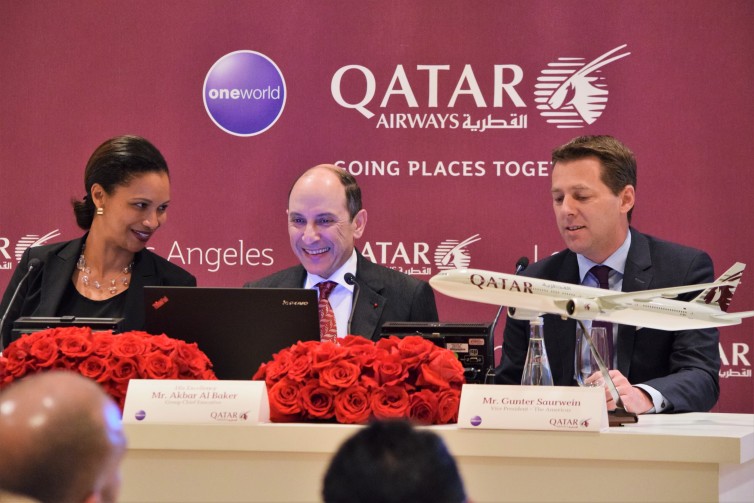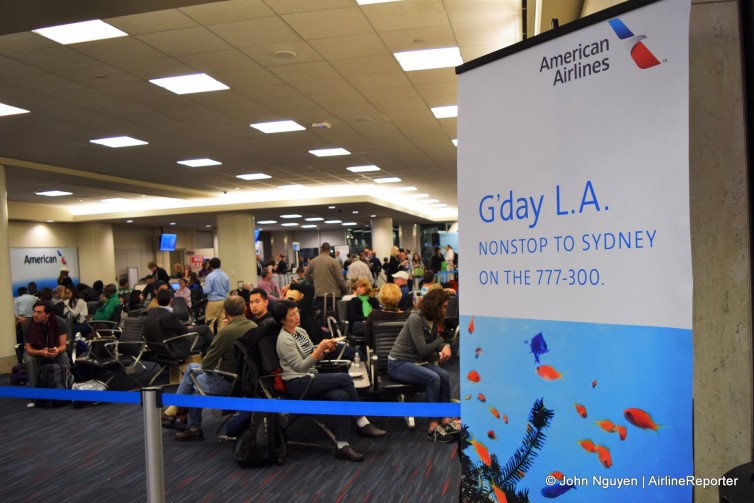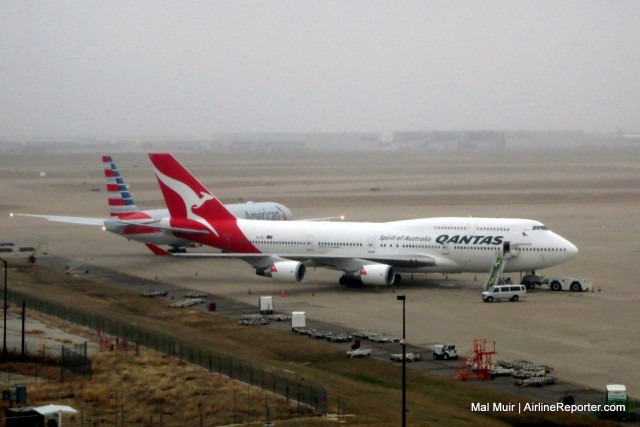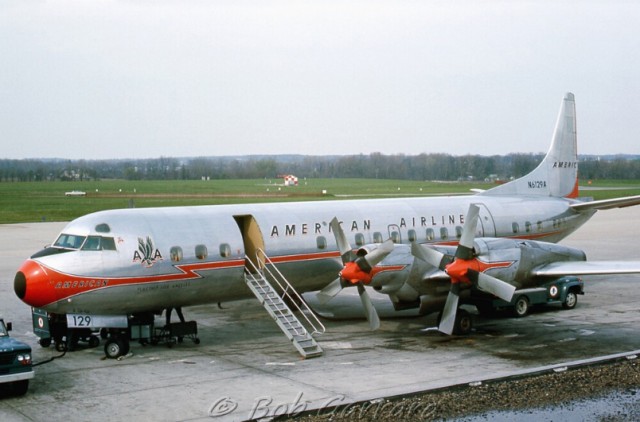
At the Qatar press conference on January 12, 2016 in Beverly Hills, with LAWA Director Deborah Flint, His Excellency GCEO Akbar Al Baker, and Qatar’s VP for the Americas Gunther Saurwein (L-R) – Photo: John Nguyen | AirlineReporter
Qatar Airways held a press conference on Tuesday to highlight the carrier’s entry into the Los Angeles market, with His Excellency, Qatar Group CEO Akbar Al Baker, providing his insights into the new service, as well has having some choice words regarding what he views as an unwarranted attack on his airline by the three big US-based carriers. AirlineReporter was on hand to live-tweet the event, and Al Baker did not disappoint.

The departure lounge for Gate 41 at LAX, for American’s inaugural flight to SYD. #AvGeeks cringe at this banner…
Updated 12/22/2015 @ 4:38pm PT
Want a chance to win a gift bag, courtesy of American Airlines? Scroll down, leave a comment below, and a winner will be randomly selected!
With critters, music, food, gifts, and didgeridoos on hand, American Airlines celebrated its inaugural flight from Los Angeles to Sydney last Thursday, marking the first time the airline has directly flown to Australia from the contiguous 48 states with its own aircraft, this route featuring its flagship Boeing 777-300ER.
But even hard-core AvGeeks would be hard pressed to focus on the 777 on the other side of the windows when there was a baby kangaroo (WHAT?!)…

A Qantas 747-400ER and an American 777 on the ground at Dallas-Fort Worth… Soon a sight for Australian airports?
Traveling down under to Australia is one of the most heavily-restricted air travel markets. However, yesterday Qantas and American Airlines make some changes to their services over the Pacific to increase opportunities. As of the middle of December 2015, both American (AA) and Qantas (QF) are going re-add services that were previously cut.

American’s First Boeing 777-300ER, N718AN, seen at DFW Gate D-23, the day of departure flew the inaugural flight. It signifies the birth of a new airline.
This is a continuation of Chris Sloan’s (@Airchive) report on flying on the inaugural American Airlines Boeing 777-300ER to Sao Paulo. Be sure to also check out PART 1 of the series.
The day began with a contingent of press crawling around and photographing the cabin, more on that later. The 2 Boeing 777-300ERs were at Gate D-23 (our inaugural aircraft) and another unpainted at D-24 for an employee event and to be used as backup. For an inaugural, the gate events were remarkably low-key. Missing were the obligatory ribbon cutting, cake cutting, ice sculpture, and balloon canopy.

Business in the front and party in the back! Reactions to the new livery were mixed: The updated Eagle icon, ’œbillboard’ American typography, and silver mica paint were generally well received. The flag on the tail was critiqued as being gaudy and incongruous with the elegance of the fuselage. In person, it is much more appealing and grows on you.
Downplaying the event seemed intentional because in this transition period with so much ’œup in the air’, AA had to strike the right tone in not wanting to seem extravagant or over-the-top. With this being mostly a revenue flight with very few VIPs, many in the gate weren’t even aware of the significance of the moment.

We won’t be needing ETOPS today with most of our flight over land.
There was a small snack buffet including 777 commemorative cookies, some ’œNew American’ signage, and a few words from American CEO Tom Horton and Chief Commercial Officer Virasb Vahidi with a particular shout out to the onboard products design team led by Alice Lieu. With that, the boarding began of this entirely sold out flight.

American’s First Boeing 777-300ER, N718AN, seen at DFW Gate D-23, the day of departure flew the inaugural flight. Much more than just a new aircraft joining the fleet, It signifies the re-birth of an iconic airline. Image from Chris Sloan / Airchive.com.
This is a multi-part story written by Chris Sloan (@Airchive) on the changes at American Airlines and the inaugural Boeing 777-300 flight to Sao Paulo.
On January 31, 2013 American Airlines launched their first Boeing 777-300 ER into service with attention that rivaled any airline’s launch of a new type in recent memory. On the face of it, even though American became the first operator of the 777-300 in the United States, this event would almost seem overkill if for that reason alone. After all, American began 777-200 flights back in 1999 and the first 777-300 was first delivered to an airline, Cathay Pacific back in May, 1998. The first 777-300ER entered service nearly 10 years ago with Air France. Boeing’s two stretch variants of their venerable cash cow, the 777, easily have become the type’s most popular versions with over 680 orders and deliveries between them out of the entire 777 program’s 1,380 orders and deliveries. (as of December, 2012). In an era of smaller airliners, American inaugurated the 777-300, the largest new airliner by a U.S. carrier since the last Boeing 747-400s entered service with U.S. airliners in the late 1990s.
This inaugural, flight 963, from Dallas/Ft. Worth to São Paulo, Brazil in the author’s view is one of the most significant in the airline industry in years because it is about something much bigger than just the launch of a new airliner, it’s about the re-birth of a proud American institution that happens to bear the name of our country ’“ American Airlines.

American Airlines Electra at Port Columbus International Airport (CMH) in 1967. Image by Bob Garrard.
American Airlines problems are well known. After becoming the world’s largest airline with its 2000 acquisition of TWA, the 2000s were not kind at all to the Silver Bird. TWA and American merged during an economic downturn and by most accounts, the merger was anything but an unqualified success.
American shed most of TWA’s assets, routes, staff, and many of its aircraft. On September 11th, 2 of American’s airliners, their crew, and passengers were forever lost in the atrocities of this horrible day. As if things couldn’t get any worse, the world’s airline industry hemorrhaged with the U.S. legacy carriers losing more money during this time then they had profited in their entire history. All of them declared Chapter 11, with the exception of American. Under the category of ’œno good deed goes unpunished’, this decision would come back to haunt American for years.







